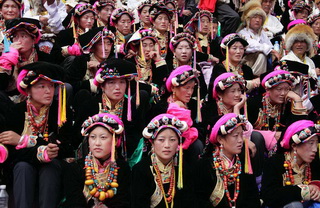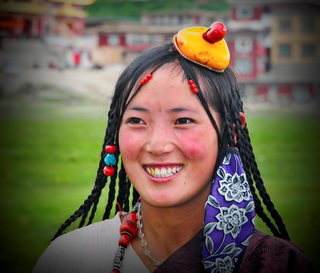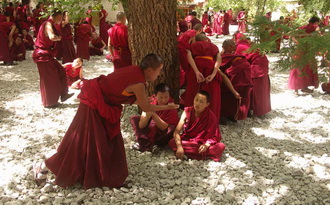
 China Tours
China Tours Tibet Tours
Tibet Tours China Theme Tours
China Theme Tours Off The Beaten Track
Off The Beaten Track Yangtze Cruises
Yangtze Cruises China Trip Planner
China Trip Planner Travel Agents
Travel Agents


We had a wonderful time in Tibet. We have learned a lot about this unique destination because of the wonderful guide Degyi who is so knowledge and always available towards our tours. We stayed at the Shangri-La Hotel Lhasa, and we would never imagine a Tibet travel could be so nice and amazing without the help of Degyi.
Also, thanks a lot to our Tibetan driver Mr.Wongdun for his safe driving and a good sense of service along the way.
We shall return Tibet in the near future!
P.B. and A. A - Europe
Tibet Travel
June 2018 (Private Tibet Journey from Kathmandu)

 Owing to its high elevation and bad transportation conditions, Tibet has long had few exchanges with the outside world. Its solitude serves to help the birth and maintenance of the exotic Tibetan culture. Tibetan costumes vary within different districts, professions, social status, seasons, occasions and genders in materials, styles, colors, and accessories and so on. It is said that there are over 200 kinds of Tibetan costumes, which ranks first among the ethnic groups in China.
Owing to its high elevation and bad transportation conditions, Tibet has long had few exchanges with the outside world. Its solitude serves to help the birth and maintenance of the exotic Tibetan culture. Tibetan costumes vary within different districts, professions, social status, seasons, occasions and genders in materials, styles, colors, and accessories and so on. It is said that there are over 200 kinds of Tibetan costumes, which ranks first among the ethnic groups in China.The style of Tibetan costumes has undergone few changes throughout history. It is mainly decided, and affected, by local climate and their nomad's way of life. Typical Tibetan costumes include long and loose garments, caps, sashes, boots, and aprons, etc.
Components of Costumes
For most of the year, the weather on the Qinghai-Tibet Plateau is extremely bad and changeable. To resist coldness, and for the convenience of manual work, most Tibetans wear loose and durable fur garments with wide sleeves. During daytime, they take off one of the sleeves to work more freely and to dissipate the heat. At night, when it is cold the garment can be used as bedclothes. Now, Tibetans often wear only one sleeve and tie the other at the waist as a kind of accessory. Sashes are necessities for a garment. When the garment is tied tightly in the middle, it produces a large bag in the front to pack useful items. It is really very practical.
Caps are indispensable for Tibetans. Caps have not only practical functions, as protecting the head from cold, but also are of great aesthetic value. Tibetans wear various caps, including caps made of sheepskin, fox skin, and Jinhuamao (a hat made of golden satin and golden ribbons). Tibetan boots are so high that they sometimes reach the upper part of the leg, with a heel of about 2 centimeters (around 0.79 foot). The insteps are often embroidered with beautiful pictures.
Materials
Most Tibetan costumes are made of animal furs. Furs are soft, durable and warm. There are a variety of furs used, sheepskin being the most common. In the past, different furs indicated different meanings. For example, a hero of the war would wear tiger skin garments while a deserter would have to wear fox skin garments. With the elapse of time, these original meanings have been lost. Sometimes, even fox skin garments are in fashion. There is a specific material that is uniquely used in Tibet: pulu. Pulu is made of sheep's wool. It is fine and soft. A high-quality pulu garment can be used as a raincoat and it is suitable to wear throughout the whole year. Cotton is also a favorable choice. In summer, Tibetans usually wear thin cotton garments. Meanwhile, there are many other materials that are used, such as silk, nylon, satin and so on.
Colors
Tibetans in the city prefer light colors while in the pastoral area women are fond of bright colors. Citizens match clothes of similar colors together, while country people make their clothes, most usually aprons, with stripes of five different colors: white, blue, green, red and yellow, which represent the cloud, the sky, the rivers, the earth, and one of the gods in their religion. Often, they put two contrasting colors together. White and black, green and red are mixed pleasantly, which generates delicate artistic effects. The match of colors shows the specific sense of beauty of Tibetans.
Accessories
Tibetans love accessories more than any other ethnic group. Accessories are to them a symbol of assets and social status. They wear all kinds of accessories, such as necklaces, hairpins, earrings, and bracelets. These accessories are made of jade, pearls, shells, bones, gold, silver, other precious stones and metals and so on. Some of these accessories are related to their religion. They design these accessories into the shape of some sacred objects in their religion in the hope that they can always stay in the protection of their Buddha. Some are mainly of practical use. For example, there is a kind of accessory named naigou (milk hook). When Tibetan girls milk the cows, they must use a hook with their buckets. After the milking, they hang the hooks on their clothes, so naigou plays a double role as a tool as well as an accessory. Now, as it is used more as an accessory, it is made more and more refined and luxurious.
We can say that the hairstyles are another kind of accessory for Tibetans. Most Tibetan men comb their hair neatly on the head, while women braid their hair into two or more plaits with colorful hair ropes, coral and pearls. Some even braid more than one hundred plaits. As a matter of fact, in most areas in Tibet, people braid different plaits before and after the adult ceremony and the marriage.
Owing to their exoticism, primitive simplicity and the auspicious meanings they symbolize, Tibetan accessories have won great popularity among Han people. Strolling at night, you can find these accessories sold almost in every modern city on sky bridges, and on both sides of the streets. To some people, wearing Tibetan accessories means they are at the forefront of current fashion. In fact, not only Tibetan accessories, but also Tibetan clothes are popular. In the souvenir shops of many scenic spots in China, Tibetan costumes are available and are the best sold goods in the shops. Tourists are attracted by their mysterious beauty and are inspired to put them on.
Costumes of Monks
The costumes of Tibetan monks are also worth mentioning. Their costumes are usually made of crimson pulu. In daily life, a monk wears a shawl with the front and the back decorated with yellow cloth, and a long skirt, and drapes another long shawl that is approximately 2.5 times the length of his height. When he attends a religious meeting he will wear a cloak and a special yellow cap. Sticking up high on the head, this neatly sewed cap resembles the shape of a rooster's comb. In fact, costumes of monks differ with different sects. For example, some other monks wear long, steeple-crowned hat with its brim folded and its front open.
With the economic development of Tibet and its gradual opening to the outside world, the style of Tibetan costume is undergoing quiet changes. Modern Tibetans have taken a liking to the costumes of the Han people. Some are even fond of western clothes. Ingenious Tibetans mix the style of Han, Tibetan and western clothes and design new clothes that catch people's eyes immediately. They now try to keep pace with the fashion while maintaining its ethnic features.
China Trip Planner | Travel Agents | About Us | Why Us | Contact Us | How to Pay | How to Book - Terms & Conditions | Site Map
Copyright © 2010 - 2030 All Rights Reserved.


 0086-28-85711328
0086-28-85711328 0086-28-85546015
0086-28-85546015




